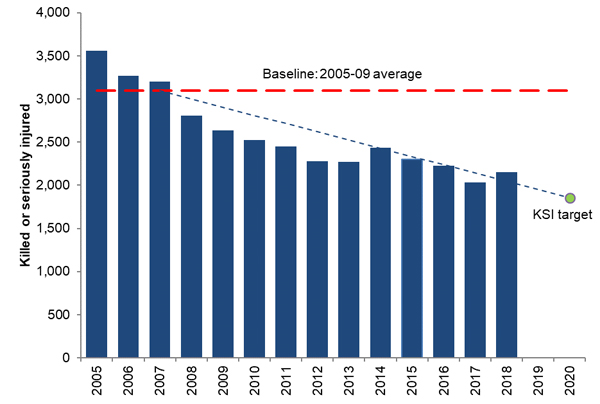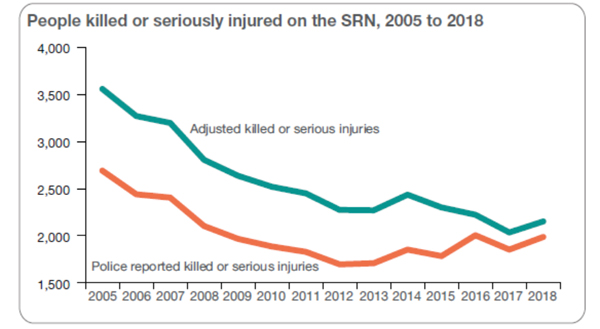Highways England is significantly off track against its key 2015-2020 road safety target, according to data obtained by Transport Network.
The government-owned company has a key performance indicator to reduce the number of people killed and seriously injured (KSIs) on the strategic road network (SRN) by 40% by 2020, against a baseline of the 2005-09 average.
Based on changes to the reporting of serious injuries the adjusted baseline is 3,094 KSIs, meaning that the adjusted 2020 target is 1,857.
When Highways England inherited responsibility for the strategic road network in 2015, adjusted KSIs had already fallen to 2,301, a drop of 26% on the baseline and two thirds of the drop to reach its target already achieved.
However, in 2018 KSIs actually increased, meaning that the cut against the baseline is still only around 30%.
To meet the target of 1,857 KSIs, Highways England would need to achieve a fall of 444 KSIs (or 19%) in 2020, compared to 2015. However, the current figure represents a three-year fall of only 6%.

Source: Office of Rail and Road
The facts
Adjusted data obtained from regulator the Office of Rail and Road (ORR) by Transport Network shows that there were 2,301 KSIs on the SRN in 2015.
According to the ORR, this fell to 2,035 in 2017, but rose by 6% to 2,152 in 2018, when there were 250 deaths and 1,902 serious injuries, both up 6% on 2017.
The recently published Road Investment Strategy for 2020-25 (RIS 2) includes a graph (below) which shows a rise in the number of KSIs on the SRN. The DfT has confirmed that the figure used here for 2018 is 2,152, the number used by the ORR.

Source: Department for Transport; Road Investment Strategy 2: 2020–2025
The DfT suggested that the increase in 2018 may have been due to a change in police reporting methods for serious injuries. However, the ORR has repeatedly made clear that the figures for serious injuries that it has used have been adjusted in response to changes to the severity reporting systems.
The importance of the target
Amidst criticism of its approach to improving road safety, Highways England's head of road safety, Richard Leonard, has always stressed that meeting the KSI reduction target is its main focus.
However, in a document last year, the ORR warned: 'The increase in the number of people killed or seriously injured on the strategic road network in 2018 puts the company’s delivery of its safety target at risk.'
The RIS 2 document argues that while there has been a long-term downward trend in KSIs on the SRN, 'opportunities to maintain this rate of progress get harder and as a result the rate of decline has slowed’.
Highways England also has a ‘Zero Harm’ goal of bringing the number of KSIs on the SRN ‘as close as possible to zero by 2040’. The RIS 2 document appears to water this down to ‘a level approaching zero by 2040’, although neither definition produces a tangible numerical target against which success can be measured.
The RIS 2 document states: ‘…the trajectory set for the next five years means Highways England remains on course for zero people killed or seriously injured by 2040. The target is therefore based on a 50% reduction against a 2005-09 average baseline, keeping Highways England broadly on the same trajectory as RIS1.’
Register now for full access
Register just once to get unrestricted, real-time coverage of the issues and challenges facing UK transport and highways engineers.
Full website content includes the latest news, exclusive commentary from leading industry figures and detailed topical analysis of the highways, transportation, environment and place-shaping sectors.
Use the link below to register your details for full, free access.
Already a registered? Login